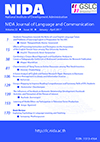A Genre Analysis of English and Korean Research Paper Abltracts in Electronic Resource Management in Library and Information Science
Keywords:
Genre Analysis, Journal Abstract, Move AnalysisAbstract
This study aims to answer how the journal article abstract currently represents the main text of the journal article and what role the abstract plays. It also attempts to clarify how the structure of abstracts in Korean and English is different in the same academic area. In order to address this issue systematically, this study examines the textual organization of selected journal article abstracts in library and information science. Specifically, it focuses on the investigation of rhetorical structures and linguistic realizations based on the theoretical framework of “move analysis” as originally proposed by Swales (1990) and Hyland (2000). The results of this study clearly point out that there are differences in the frequency of the occurrence and distribution of five structural moves (introduction-purpose-method-results-conclusion). An abstract in English predominantly uses the introduction move, resulting in the preferred structure of “introduction-purpose-method,” while in Korean there is a predilection toward the results move means a likely “introduction-purpose-methodresults” structure. Furthermore, whereas most journal articles allocate a small portion to the method part in the abstract, this research found that English language abstracts in library and information science allocate the longest portion to the method move part, which consists of 46 words on average. In contrast, in Korean language abstracts, the results move is the longest move, with an average of 40 words.
Downloads
How to Cite
Issue
Section
License
By submitting a manuscript, the author transfers the copyright for the article to School of Language and Communication, National Institute of Development Administration (NIDA), if and when the manuscript is accepted for publication. Though the journal is an open-access, reproduction of any material published in NIDA Journal of Language and Communication for non-personal and/or commercial purpose requires a written permission from School of Language and Communication, National Institute of Development Administration (NIDA).






